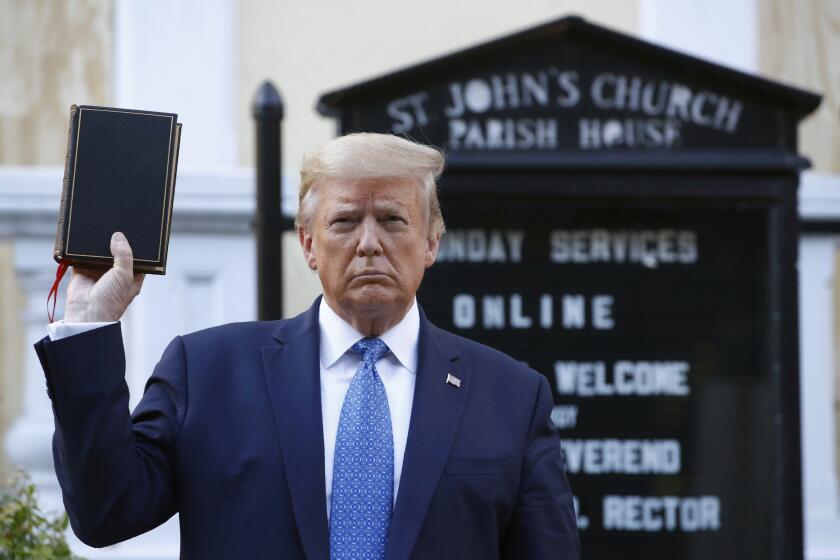Opinion: What isn’t on California’s ballot today: real choice
If this year’s presidential race has shown anything, it’s that large numbers of voters want more choice. As a result, electoral reforms like ranked-choice voting and proportional representation are being discussed more widely.
In Maine, ranked-choice voting is on the statewide ballot today. If approved by voters, it would be used to elect Maine’s members of the U.S. Senate and House as well as its governor and state legislators. Ranked choice allows voters to list multiple candidates in the order of their preference; votes are transferred until a single candidate receives a majority. This system is already in use for municipal elections in Alameda and San Francisco counties.
But for elections to statewide and legislative offices and to the U.S. Senate and House, California’s top-two system restricting November ballot access to the pair of candidates that won the most votes in the primary limits choice.
Look at the race for U.S. Senate: Despite 55% of Californians being registered as other than Democrats, 100% of California voters can choose only between two Democrats. This isn’t the only example: Of the 153 races for state Legislature and U.S. House seats on the ballot today, 24 are between two Democrats and four are between two Republicans.
For general elections, only 11 candidates from these parties made it to the ballot in 459 races for the state Legislature and Congress in 2012, 2014 and 2016.
But top-two doesn’t just eliminate choice for Democrats and Republicans; it has almost completely eliminated the state’s other longtime ballot-qualified parties as well. For smaller party candidates to qualify even for the primary election ballot, they need a higher number of signatures now than under the old system, effectively barring ballot access to third parties.
The result: From 1992 to 2010, the Green, Libertarian, Peace and Freedom and American Independent parties averaged 127 primary ballot candidates each election year. In 2012, the first year of the top-two system, only 17 candidates from these parties qualified for state legislative and congressional primary election ballots; and by 2016, only nine qualified for state Legislature and Congress ballot spots, and four for U.S. Senate.
For general elections, only 11 candidates from these parties made it to the ballot in 459 races for the state Legislature and Congress in 2012, 2014 and 2016 combined — and only in places where a single Republican or Democratic candidate qualified for the primary ballot, leaving second place open.
Why does this matter? By limiting voter choice to only two general election candidates, top-two denies many voters the option to vote for someone who represents their views, leading to false majorities that misrepresent voter preferences. The one exception is for president, where top-two does not apply. There, the dynamics are instructive.
Despite receiving billions of dollars of free media, presidential candidates Hillary Clinton and Donald Trump together barely cracked 80% in most four-way polls taken in late summer and early fall — polls that also included Green Party nominee Jill Stein and Libertarian Party nominee Gary Johnson. Even that 80% was soft, because many supporting either Clinton or Trump are doing so primarily to oppose the other. Poll questions often ask tactical questions like, “If the election were held today, for whom would you vote?” rather than, “Which candidate best represents your views?”
Young voters support Stein and Johnson in far higher percentages than do other groups. But if our presidential elections were held under top-two rules, neither Stein nor Johnson would even be on the general election ballot. For single-seat races like president and U.S. Senate, the democratizing reform is not less choice, as under top-two, but more choice from among multiple candidates via ranked-choice voting.
This points to one of the most problematic aspects of top-two: It inhibits the evolution of the politics of our state. One reason California has so many voters not aligned with any party is that single-seat, winner-take-all elections generally produce two electorally dominant parties that do not necessarily represent the full electorate. Top-two makes this even worse, by funneling independents into voting for Democrats and Republicans, while eliminating other voices.
In his insightful Oct. 5 op-ed article in The Times, political scientist Larry Gerston rightly observes that “the top-two system denies dissatisfied voters the opportunity to choose an independent or minor party candidate,” which he says “is often the mark of a protest vote expressing disgust with both major parties.” But Gerston doesn’t go far enough in recommending alternatives, because disgusted voters deserve more than the right to protest — they deserve actual representation.
How to achieve this? In countries that elect their legislatures through multiseat districts with proportional representation (where, if a party gets 20% of the vote, for example, it wins 20% of the seats), many otherwise “independent” voters are members of parties that actually reflect their views, parties that are able to achieve representation under such a system.
The result is voter turnout much higher than in the U.S., because more voters have a chance to elect someone who reflects their views — and more of the diversity of society at the table of their democracies. We deserve the same here.
California should be a leader in giving voice and representation to all voters. It is time to abandon top-two and replace it with elections that provide proportional representation and ranked-choice voting, giving all voters a chance to elect someone who represents their views.
Michael Feinstein, a spokesman for the Green Party of California, was a member of the Santa Monica City Council from 1996 to 2004.
Follow the Opinion section on Twitter @latimesopinion and Facebook
More to Read
A cure for the common opinion
Get thought-provoking perspectives with our weekly newsletter.
You may occasionally receive promotional content from the Los Angeles Times.






